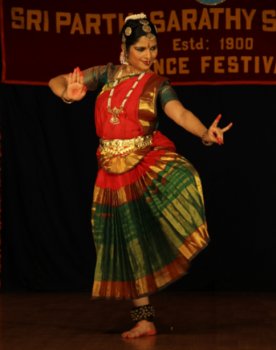
|   |

|   |
Bharatanatyam recital by Radhika Ramanujan - B Sreenivas e-mail: sabhapathi@gmail.com March 13, 2012 Radhika Ramanujan, disciple of Kiran and Sandhya Kiran, presented a Bharatanatyam recital under the auspices of Sri Parthasarathy Swami Sabha at RK Swamy Hall, Chennai. Well trained, highly articulate and consummate artist that she is, it was a memorable evening for rasikas who witnessed her recital.  Radhika started her recital with a Ganesha stuthi followed by the Varnam ‘Sri Krishna Kamalanatho’ in raga Reetigowla, a musical composition of T Srinivas of Bangalore with verses from Narada Pancaratra by Vyasadeva. The many episodes from Krishnavatara were brought to life eloquently by the dancer. True to her gurus’ bani, the manodharma behind her interpretation and choreography are worth mentioning. Fulfilling the anubhava of an enjoyable experience, the postures, gestures, body movement, footwork and eloquent eyes of the dancer held the attention of the audience throughout. The majestic portrayal of Krishna as the Lord of the Universe in the battle field of Kurukshetra was commendable. This was followed by the padam ‘Netranthi nerathile’ in ragam Huseni composed by Subbaramaiyer. She depicted the khandita nayika in this piece, which ends with the efforts of the nayika trying to convince her beloved to come back to her. One has to pay great attention to the shift between the moods that the nayika goes through and Radhika substantiated her transitions with actions that justify the transitions. The distinction between bhakti sringara and sringara itself is rather fine and Radhika managed to carry through comfortably. A touch of subtlety would have probably made it more aesthetic. Radhika treated the audience to a Tulsidas bhajan ‘Sri Ramachandra Kripalu Bhajamana’ in raga Misra Pooriya Dhanasri with the mellifluous singing of Srivastava, although it was recorded music. In this piece, a summary of Rama bhakti, Radhika's movements and striking turnings had a scintillating flow and the Sabhari encounter was conveyed with élan. Radhika’s control over abhinaya was comprehensive in these two absolute abhinaya items. The recital concluded with a thillana in raga Madhuvanti, a composition of Lalgudi G Jayaraman, followed by the mangalam. She spanned the stage with ease and maintained the araimandi posture with a perfect sense of tala throughout. The kala pramana (time sense) and execution of theermanams require special mention. The dance presentation was ample evidence to what many years of intense practice and unstinted devotion to the art form can bring to the stage. |